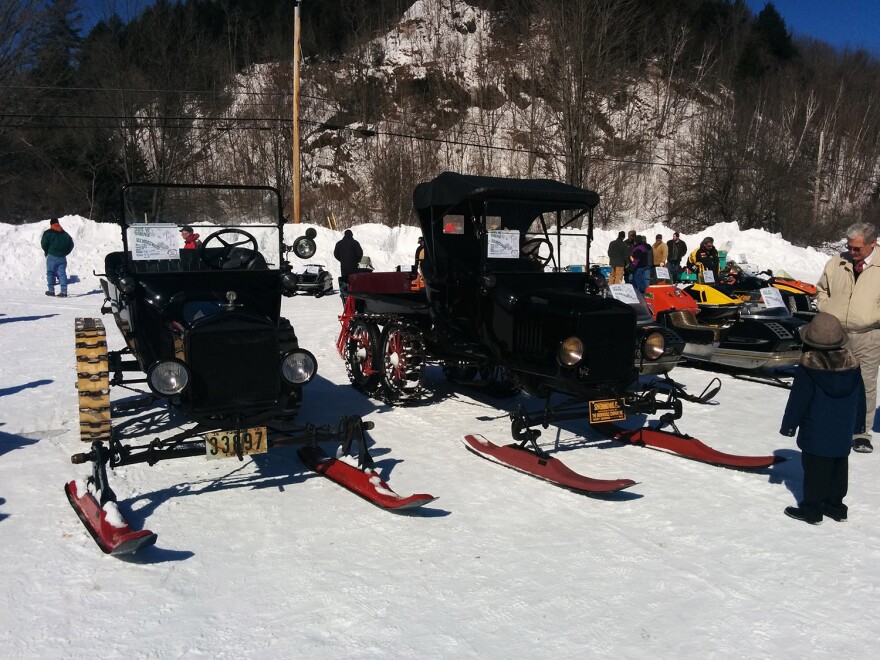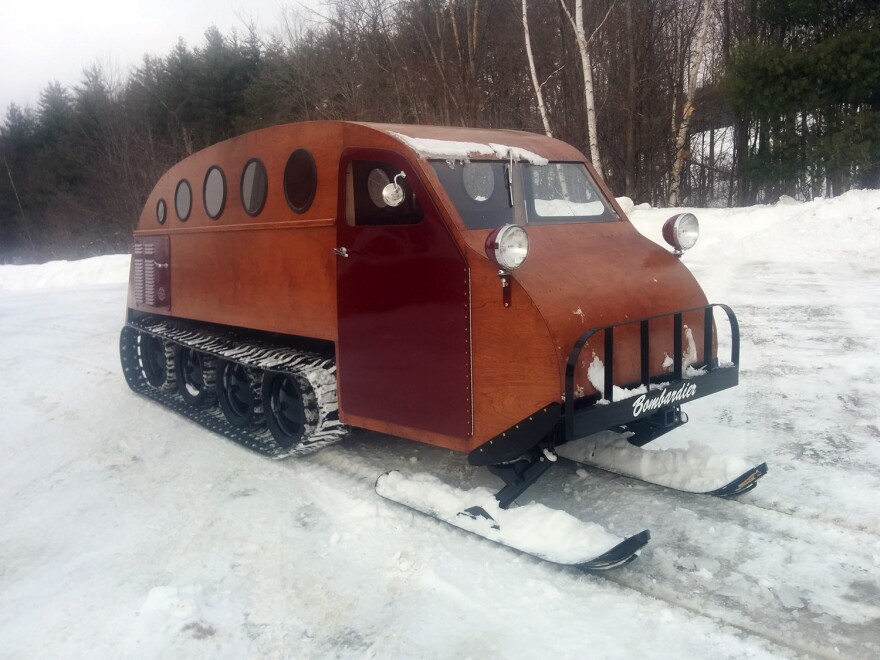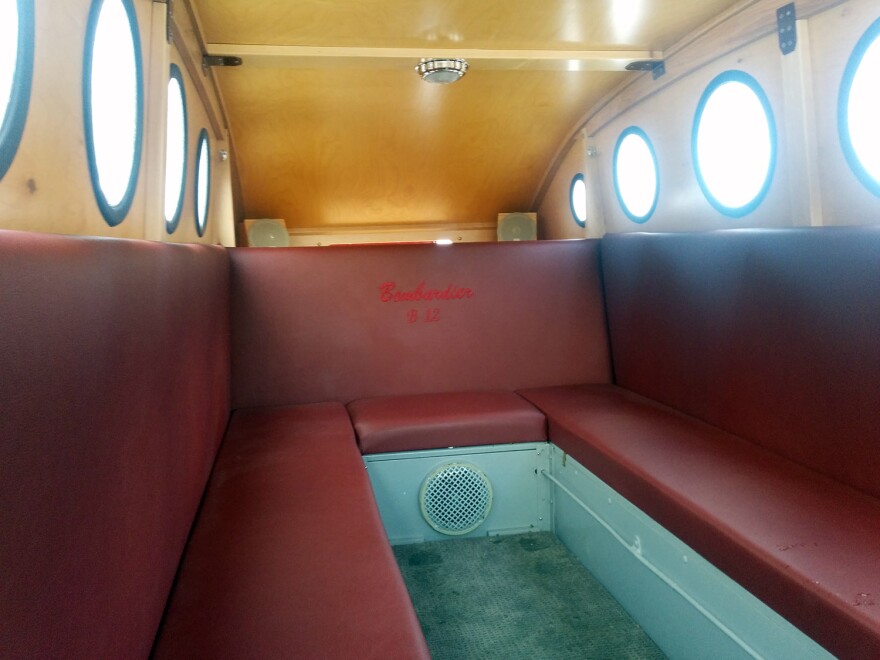On a recent weekend, dozens of vintage snowmobiles were on display in a farm field in Bethel. To qualify as vintage, they had to be made no later than the early 1980s – but a couple of them dated back to the 1920s.
When I got to the gathering on Route 107 a couple miles north of Bethel, I was hoping that one of the Model T’s would be there and sure enough, they were.
Thanks to a Ford dealer in Ossipee, N. H., starting in 1922 people who owned a Model T could buy a conversion kit that replaced the front wheels with 5-foot long skis and added a second axle, an extra pair of wheels and tracks in the back. The kit cost $400, more than the car itself.
"These were sold with the intention that you could take all the stuff off and then turn your snowmobile back into a car for the summertime, but it was a lot of work,” says Brian Moriarty of Ashland, N. H. “It might be a day and a half, two days work to completely put your car back together.”

Moriarty makes all the parts needed for the snowmobile conversion kit, so if you happen to have an old Model T sitting around in your barn and you want to turn it into a sled, he’s your man.
Moriarty estimates that there are about 400 or so of these Model T snowmobiles still around, although many are in museums and not tooling around in the snow. They did have some drawbacks: You had to drain the water from the radiator and the oil from the engine if the vehicle was left out in the cold, or else it wouldn’t start.
"It was better than snow shoes, but it was a lot of work,” Moriarty says.
About a third of the 12,000 conversion kits manufactured went to Africa and the Middle East to be used on vehicles that were driven through sand.
Moriarty takes his 1922 Model T snowmobile out most weekends in the winter, sometimes towing a 19th-century sleigh. He says back in the day, these primitive snow machines were used on what he refers to as “rolled roads.”
Starting in 1922, Model T owners could buy a conversion kit that replaced the car's front wheels with 5-foot long skis and added a second axle, an extra pair of wheels and tracks in the back.
"They used to take horses and roll the roads with big rollers, and that’s where they performed the best,” Moriarty says. “They will go through two or three feet of virgin snow, unless it’s the real mushy kind that you get in March, and then they get stuck real easy and they’re – you might want to wait ‘til spring instead of shovel and push."
The vintage snowmobile gathering was organized by Alex Riesterer, who has more than two dozen old machines in his barn in Bethel. Riesterer says snowmobile manufacturing peaked in the 1970s.
"Anybody who could possibly market a snowmobile was marketing a snowmobile back then. A lot of them were re-badged. It was another manufacturer and they just slapped their own sticker on it. You know, J.C. Penney sold them out of their catalog. Sears sold them. Massey-Ferguson the tractor maker, John Deere. The list is about 200 manufacturers long,” says Riesterer.
That list of manufacturers is now down to just four. Many of the vintage snowmobiles at the Bethel gathering were small and low to the ground compared to modern sleds. There was a snowmobile made by Chrysler in the late 1970s that wasn’t much bigger than a skateboard, a Kitty Cat snowmobile for kids and a few Thunder Jets, Canadian-made snowmobiles that were very successful on the racing circuit in the early ’70s.
The Thunder Jet was designed in Vermont and debuted at the Thunder Road Speed Bowl in Barre. Some owners of these rare vintage snowmobiles never take them out in the snow, but Alex Riesterer says that some of them do.
“Part of the fun is the treasure hunt for parts, because you can’t just run to the parts dealer,” Riesterer says. “Most of these brands don’t exist any more. You never know where you’re going to find them. I’ve found them in barns right around the corner. I’ve gone to Connecticut and New York to pick them up. And there’s kind of, almost a little cottage industry of people who are driving back and forth across the country, trucking snowmobiles from the West and Midwest out to here and vice-versa."
"There's kind of, almost a little cottage industry of people who are driving back and forth across the country, trucking snowmobiles from the West and Midwest out to here and visa-versa." - Alex Riesterer
A couple of the old snowmobiles had pretty old riders attending them. Ninety-year-old Marcel Smith of Barre showed off his small, half-century-old Arctic Cat, which was painted fire engine red and bore an inscription in memory of his late wife Ruby.
"My wife bought this for me in 1963. She bought it unbeknown to me and give it to me for Christmas,” Smith says. “Then I gave it to my son and we restored it, so it’s still going good. Of course back then I had five kids and they all rode it double, including the neighbors, so there’s a lot of miles on it."
The one disappointment at the vintage snowmobile gathering was the absence of a snowcoach. They were made in Valcourt, Quebec beginning in the 1930s and look like small armored personnel carriers with 10 porthole style windows. So, I drove to Rutland where David Fucci took me out for a spin in his 1948 snowcoach, which took more than a year to restore and has plywood walls.

“They were school buses, mail delivery, ambulances,” Fucci says. “’Cause up until the early ‘70s in the Eastern Townships right across the border, they never plowed the roads.”
The snowcoach was also used by priests in rural parishes, forestry companies and utilities. The story goes that the Quebec mechanic who developed it, Joseph-Armand Bombardier, was motivated, in part, by the death of his young son, who could not be transported to a hospital because of snow on the roads. The snowcoach has tracks around its eight wheels and, like the Model T, two skis in place of front wheels. Inside there’s a U-shaped bench.

“This was considered a 12-passenger,” Fucci says, pointing to the tight quarters. “So, as you can see, putting 12 people in here, they’d be in here pretty tight,” he adds, laughing.
Fucci’s snowcoach has been known to stop traffic when it rides through fields in Rutland. It turns out there are several snowcoaches in use at Yellowstone National Park. But you don’t have to journey to Wyoming to ride in one. There are still a few driving around in Quebec, and Fucci may bring his snowcoach to next year’s vintage snowmobile gathering in Bethel.





